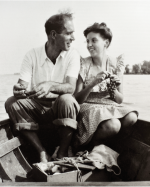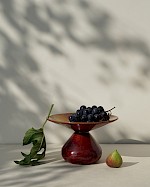Carlo Sbisà and Mirella Schott are two artists from Trieste who began an artistic collaboration after their marriage in 1943. They began designing and creating beautiful ceramics that were registered under the CSM (Carlo Mirella Sbisà) label during the war and post-war years.
The collaboration with his wife led to the creation of objects that are both similar and, above all, unique in their seriality. In this new creative adventure, they were not at all interested in artist’s ceramics, in the unique piece “signed” unequivocally, as Picasso had begun to do. They did not approach ceramics as painters, as many artists had done or would have done; nor were they attached to modelling on the potter’s wheel. Sbisà and Schott, on the other hand, started from a global idea of the object, and did not at all think that they could entrust others with the preparation of the support and then intervene in the decoration; they thought of total control of the process, from the model to the mould, right through to the finishing and decoration.
For them, making “ceramics” meant being able to open up the field to experimentation, even to risk, to the unexpected; and to play, to the freedom of colour, to the probability of form.
Their work was exhibited at the 1950 Venice Biennale, and that same year they took part in the national ceramics competition in Faenza.
Carlo Sbisà, born in Trieste on 25 May 1899, was a painter and sculptor who graduated from the Accademia di Belle Arti in Florence. In addition to his paintings, he produced numerous frescoes in the 1930s and 1940s. After 1945, Sbisà, an eminent painter of the first half of the twentieth century, decided to give up painting to become a sculptor and ceramist. Sbisà died in Trieste in 1964.
Mirella Schott, born in Trieste in 1921, was a painter and ceramist who loved art from an early age. It was Carlo Sbisà who introduced her to the study of painting. In 1943, Mirella married Carlo. She exhibited her work at the Venice Biennale in 1948 and 1964. From 1960, she devoted herself to teaching at the Free School of Engraving, founded by her husband Carlo. Mirella died in Trieste in 2015.

